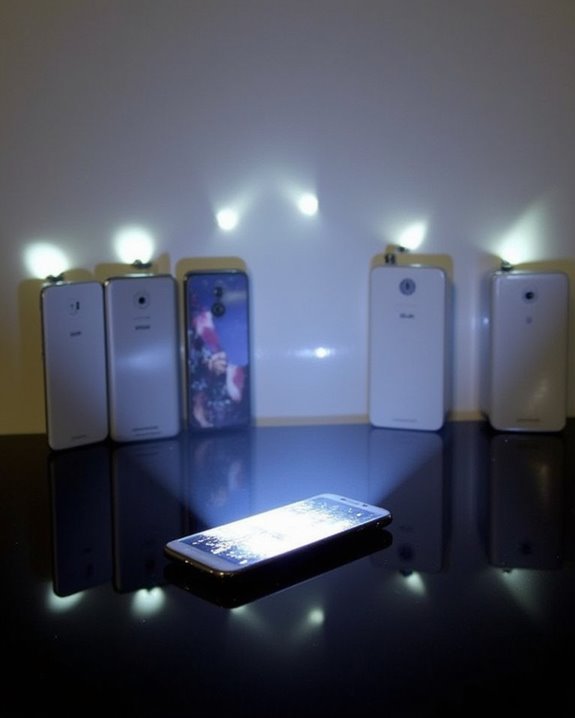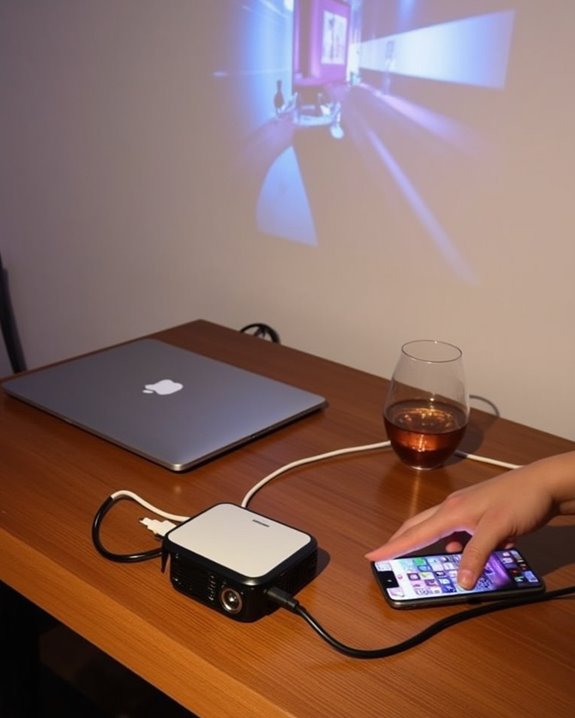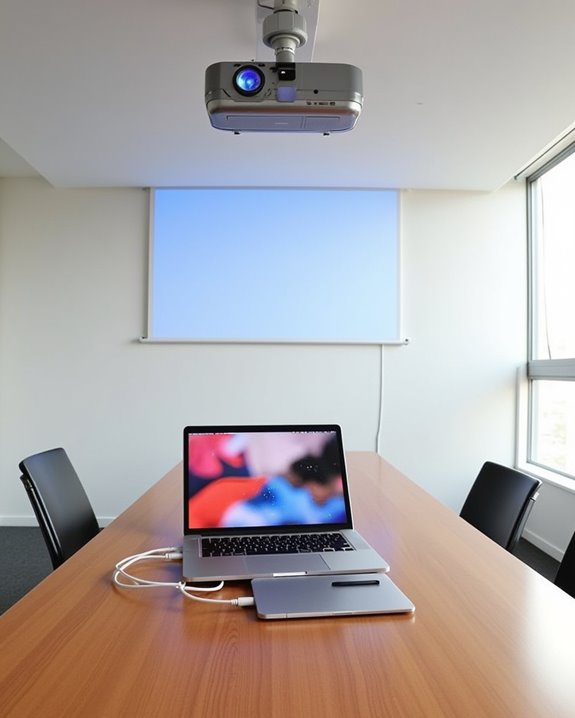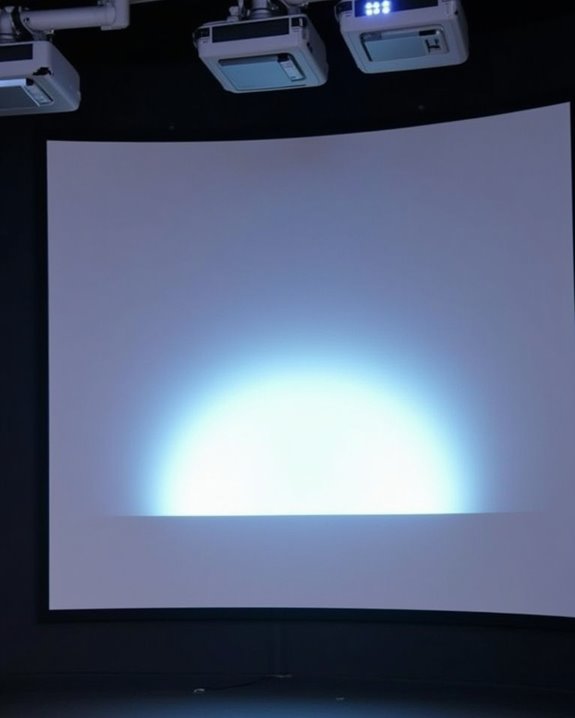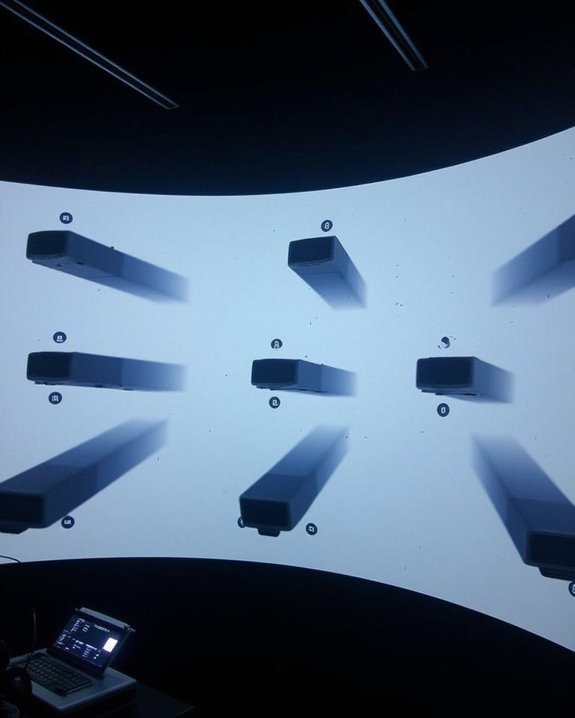If you’re curious about phones that feature built-in projectors, you’ll find that a few select models have integrated this technology, allowing you to display images, videos, or presentations directly onto surfaces without extra devices. These phones, such as the Samsung Galaxy Beam and more recent rugged models like the Oukitel WP100 Titan, typically include features like auto keystone correction, ultra-short throw projection, and high-capacity batteries, offering a portable solution for both entertainment and professional use, but availability and performance vary markedly across different brands and generations.
Key Takeaways
- Samsung Galaxy Beam is a well-known early smartphone with a built-in projector.
- Modern projector phones include models like Oukitel WP100 Titan, TANK 2, and Ulefone Armor 34 Pro.
- Many projector phones use DLP technology, offer auto keystone correction, and project images up to 150 inches.
- Rugged projector phones often feature large batteries (up to 33,000mAh) for extended outdoor or professional use.
- These devices are available from online retailers and manufacturers, with prices varying based on features and durability.
Overview of Phones With Built-In Projectors
Although smartphones have evolved with a wide range of features, phones with built-in projectors stand out by offering a unique way to share content beyond the limits of a standard screen. You’ll find these devices are designed for both entertainment and professional use, allowing you to project images, videos, or presentations wherever you go. The concept dates back over a decade, with early models like the Samsung Galaxy Beam, and has since seen innovations focused on portability and versatility. Modern portable projectors emphasize features such as auto keystone correction to ensure easy setup and clear images. Battery life is a critical consideration, as running a projector can quickly drain power, so models like the Oukitel WP100 Titan prioritize larger batteries. Design aesthetics must also balance the projector’s integration without adding excessive bulk or compromising functionality, resulting in compact, practical devices for on-the-go content sharing. In 2025, Ulefone Armor 34 Pro was officially announced with a built-in projector, combining rugged durability with multimedia capabilities.
Key Features and Specifications of Projector Phones
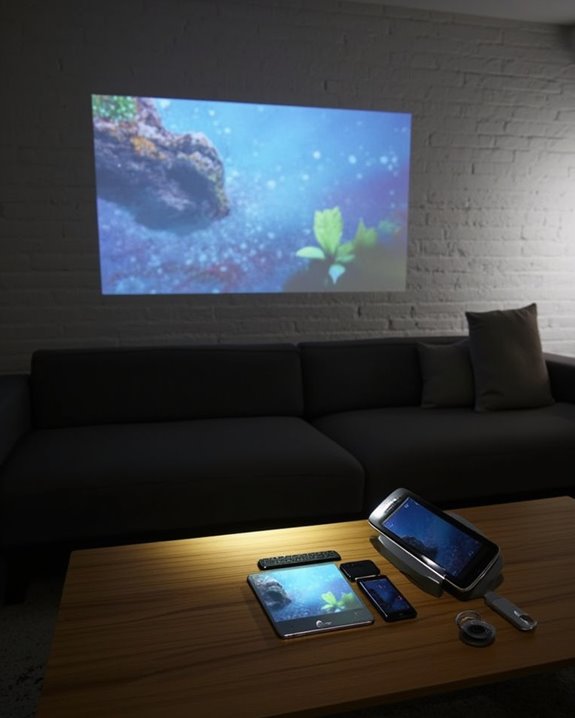
When you look at what sets projector phones apart, it’s the combination of specialized hardware and thoughtful engineering that enables them to function as both smartphones and portable projectors. These devices commonly feature DLP technology for projection, with resolutions around 854 x 480 pixels and brightness levels near 100 lumens, supporting projection sizes from 40 to 150 inches. You’ll notice thicker, heavier designs—like the Tank 3 Pro at 697g—to accommodate large batteries, which are essential for extended battery life during projection. Some models, such as the TANK2, feature a built-in laser projector for versatile use in a variety of environments. Many projector phones also incorporate auto keystone correction and adjustable stands to improve image alignment and ease of setup.
Advanced camera systems offer high-resolution sensors, night vision, and wide-angle options, while robust processors and up to 18GB RAM ensure smooth performance. Most models run recent Android versions, supporting regular software updates for security and app compatibility, alongside ample storage and microSD expansion.
Market Availability and Pricing Information
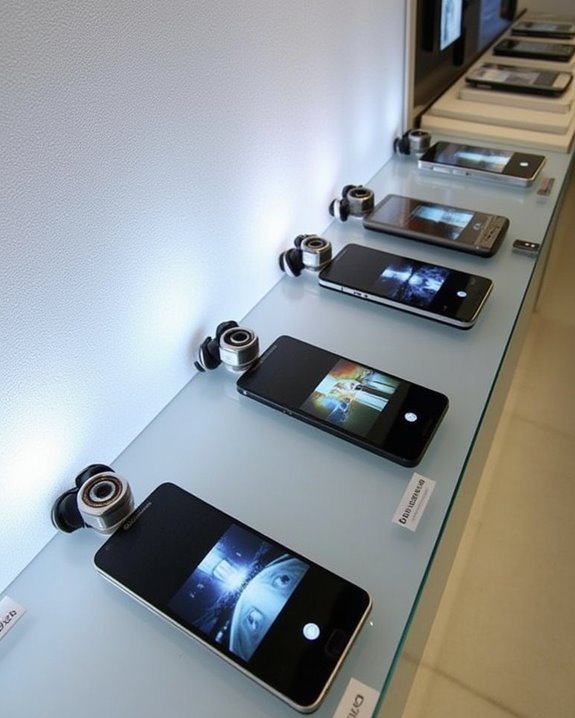
Whether you’re searching online or visiting specialized tech retailers, projector phones are accessible through various distribution channels, with global availability that caters to both mainstream and niche markets. You’ll find these devices listed on major e-commerce sites like Amazon and eBay, as well as from direct manufacturers and smaller third-party sellers, reflecting a market that’s not saturated but steadily growing in response to increasing consumer demand. Prices typically range from a few hundred to over a thousand dollars, depending on factors like projector brightness, battery size, and smartphone specifications. Rugged models such as the TANK 2 and Oukitel WP100 Titan command different price points due to their durability. Regional preferences, economic factors, and retailer promotions can also impact both the availability and the final cost you’ll encounter. For example, the Oukitel WP100 Titan was released on Amazon in mid-April with an initial retail price around $899, and early supporters could access it for as low as $599 through Kickstarter campaigns. Many projector phones incorporate ultra-short throw technology, allowing them to project large images from minimal distances, which enhances their versatility for various environments.
Technical Breakdown of Projector Phone Models
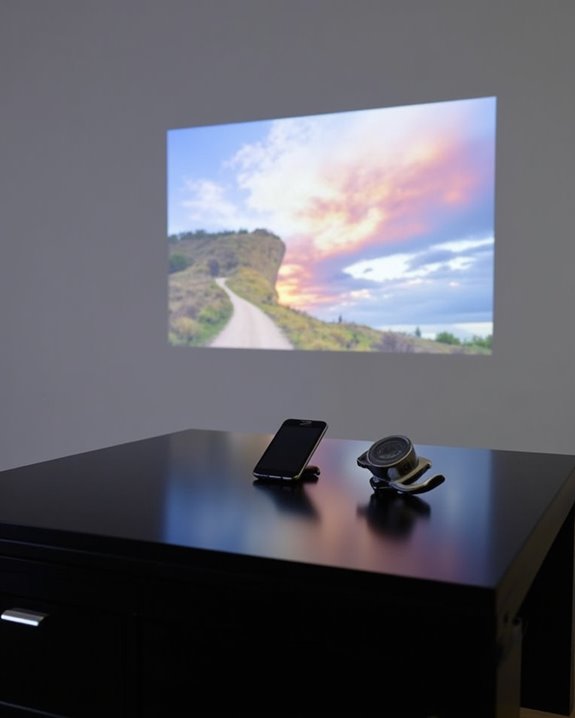
If you’re interested in what makes projector phones unique, it’s important to look closely at their technical specifications, which combine advanced smartphone features with integrated projection capabilities. Most models, like the Tank 3 Pro, offer a high display resolution—such as a 6.79-inch FHD screen at 120Hz—ensuring sharp visuals both on the phone and when projecting content. Battery capacity is another key aspect, with devices like the Tank 3 Pro offering a 23,800mAh battery and fast charging up to 120W, while some generic models boast capacities as high as 33,000mAh, supporting week-long use. Internally, you’ll find powerful chipsets like the Mediatek Dimensity series, up to 16GB RAM, and durable designs featuring IP68 ratings, making these phones practical and robust. Network compatibility & carrier policies should also be checked before purchase, as not all projector phones will work on every cellular network due to differing supported bands and carrier restrictions.
Advantages and Practical Uses of Built-In Projectors
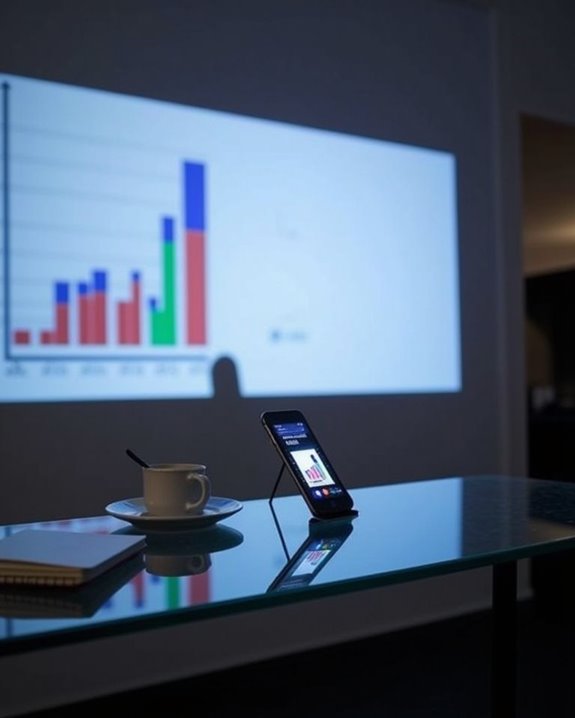
Alongside their impressive technical features, phones with built-in projectors offer a range of practical advantages that set them apart from traditional smartphones. You’ll benefit from the portability these devices provide, enabling you to project content without lugging around extra equipment, which saves both space and cost. The convenience of projecting presentations, videos, or photos directly from your phone is enhanced by a user interface designed for intuitive control, often featuring dedicated projector apps for easy setup and management. Battery life is optimized for projection use, allowing you to run presentations or entertainment sessions without frequent recharging. Built-in projectors are especially practical for impromptu meetings, educational settings, and travel, providing larger screen sizes, seamless multimedia integration, and wireless connectivity, all in a single, accessible device. In addition, these phones utilize reflected light technology, which helps reduce eye strain and makes extended viewing sessions more comfortable compared to traditional screens.
Future Innovations and Upcoming Trends in Projector Phones
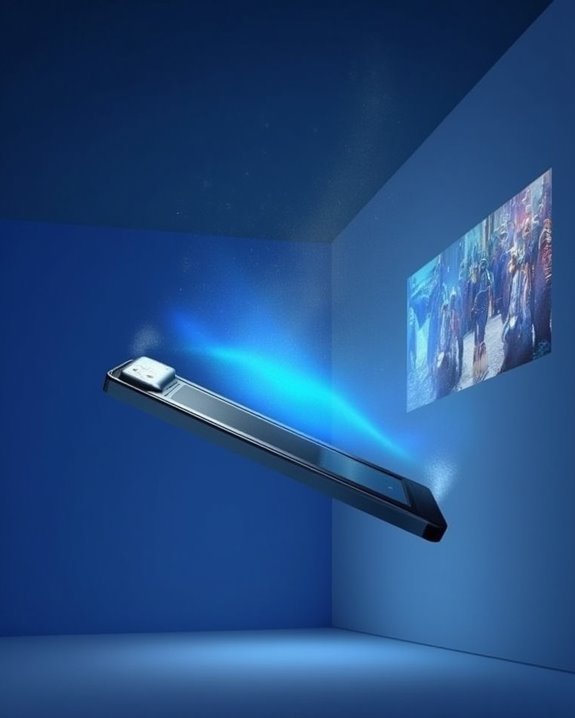
As projector phones continue evolving, you’ll notice manufacturers are prioritizing both technical improvements and user experience in upcoming models. Expect future devices to feature brighter, higher-resolution projectors, supported by AI-driven image stabilization and focus adjustment for sharper, clearer projections. New designs may include foldable screens, allowing for larger display surfaces while maintaining portability, and wireless charging, providing convenient power solutions for extended use. Rugged builds, like those on the Oukitel WP100 Titan, will be further refined for outdoor durability. Quad-curved displays, thinner profiles, and luxury materials are also becoming standard, enhancing both aesthetics and ergonomics. Integration with global 4G LTE networks remains a focus, while multi-functionality—such as built-in camping lights and night vision cameras—continues to expand real-world usability. For example, Doogee’s V Max Play features a 22,000 mAh battery with fast and reverse charging, making it not only a projector phone but also a reliable power bank for extended outdoor or professional use.
Frequently Asked Questions
How Do You Clean and Maintain a Built-In Projector on a Phone?
To clean and maintain your phone’s built-in projector, you’ll want to gently do projector lens cleaning with a microfiber cloth, avoid harsh chemicals, and regularly inspect for dust. Don’t forget projector brightness adjustment for ideal viewing and performance.
Are Projector Phones Safe for Children to Use?
Projector phones might seem like the ultimate gadget for kids, but you’ve gotta consider projector safety first. Choose models with child friendly features like parental controls, rugged builds, and always supervise use to avoid eye strain or accidents.
Can You Use the Projector While Charging the Phone?
You can usually use the projector while charging your phone thanks to strong phone charging compatibility. However, projector usage limitations include possible heat buildup and reduced performance, so watch for overheating and adjust settings if necessary during simultaneous use.
How Does Using the Projector Affect Battery Life?
Think of your battery as a fuel tank—using the projector quickly burns through it. Higher projection brightness increases battery consumption, so you’ll notice your phone’s charge drops much faster whenever you’re projecting videos or images.
Do Projector Phones Support Wireless Screen Mirroring From Other Devices?
You’ll find that projector phones usually support wireless connectivity and screen mirroring, especially from Android devices using Chromecast or Miracast. However, compatibility and performance can vary, so you’ll want to check your device and network first.

